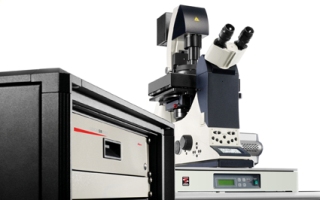Mar 9 2015
Guided by the motto “Connecting Science and Business”, Max Planck Innovation GmbH is a partner of science and industry alike. Its interdisciplinary team provides consulting services and support for scientists from the Max Planck Society with regard to evaluating inventions, applying for patents and founding companies. Max Planck Innovation thus performs the important function of transferring the results of basic research to products that are useful for both the industry and the general public.
 Leica SR GSD 3D super-resolution system for 3D localisation microscopy © Leica
Leica SR GSD 3D super-resolution system for 3D localisation microscopy © Leica
Stefan W. Hell from the Max Planck Institute for Biophysical Chemistry in Göttingen was awarded the 2014 Nobel Prize in Chemistry. His inventions in the area of high-resolution microscopy have already been implemented in successful products and are applied in biological and medical research.
On 8 October 2014, Stefan Hell, together with Eric Betzig and William E. Moerner, received the most prestigious scientific award. The prize emphasises how important light microscopy is for the life sciences, especially for virus and cancer research as well as neurosciences. By inventing the STED (Stimulated Emission Depletion) microscope, Stefan Hell revolutionised light microscopy. Due to the fact that light occurs as a wavelength, conventional light microscopes have a limited resolution: objects that are less than 200 nanometres (millionths of a millimetre) apart can no longer be discerned as two separate entities. The same applies to fluorescence microscopy, which is frequently used in biological and medical research, and is bound by this same restriction known as the Abbe limit. In conventional fluorescence microscopy, cell molecules are marked with fluorescent dyes and “switched on” using a laser beam with a particular wavelength, making them glow. If the molecules are less than 200 nanometres (nm) apart, however, they also appear as a single blur. This effect is extremely disadvantageous for biologists and medical researchers; for them, the observation of far smaller structures in living cells is decisive. In the case of the STED microscopy method developed by Stefan Hell, the resolution is no longer restricted by the wavelength of light. For the first time, it is now possible to observe intracellular structures in ten times greater detail compared to conventional fluorescence microscopy.
STED has become a key technology for researchers and medical scientists, which is why a growing number of research institutions and universities are equipping their laboratories with these devices. According to industry insiders, the market for super-resolution microscopy is currently worth up to one billion euros. Max Planck Innovation has been assisting Stefan Hell and the Max Planck Institute for Biophysical Chemistry in marketing their technology for many years. As a result of this cooperation, licence agreements for methods such as gated STED (gSTED), GSDIM (ground state depletion microscopy followed by individual molecule return) and RESOLFT (reversible saturable optical fluorescence transitions) for the development of high-resolution microscopes were concluded with a number of different companies. With its Leica TCS SP8 STED 3X and Leica SR GSD 3D microscopes, Leica Microsystems is currently the only company to market both super-resolution systems associated with this Nobel Prize. When the licence agreement for GSDIM was concluded, Stefan Hell stated: “Leica Microsystems was by far the first company to take the historical breakthrough of the diffraction limit light microscopy and implement this in products. We are glad that with GSDIM, Leica is making available another nanoscopic method – which complements STED microscopy – worldwide.” Berd Sägmüller, Head of the Confocal Imaging business segment at Leica, told Wirtschaftswoche, a German weekly business magazine: “Back then, the decision to acquire the exclusive rights to Dr Hell’s invention was very risky.” Since then, more than 150 devices were sold at a retail price of 600,000 euros each. “The production is now in full swing,” Sägmüller continues. With the release of the MicroTime 200 by PicoQuant in 2014, another microscope based on the gSTED technology recently entered the market.
In addition, Max Planck Innovation assisted Stefan Hell’s department in setting up the two spin-off companies Abberior and Abberior Instruments in 2011 and 2012. The companies were founded by Mr. Hell and those of his colleagues who were involved in implementing STED and the related RESOLFT method in his department over the past few years and fully developed it for industrial use. Based on a modular platform, Abberior Instruments GmbH now offers commercial STED and RESOLFT systems. The new easy3D STED microscope offers a resolution of below 25nm, making it 10 times better than a conventional confocal microscope. Abberior Instruments has already been awarded the “German Industry’s 2014 Innovation Award” (Innovationspreis der Deutschen Wirtschaft 2014) and the “STEP Award 2014” for the best product. The microscopes were presented to an international audience at numerous trade fairs, workshops and roadshows. The microscopes have already been installed in many European countries as well as in China.
Stefan Hell’s Nobel Prize in Chemistry is once again testament to the fact that, in addition to highly advanced devices optimised for the respective methods and applications, suitable dyes are a key component of all known super-resolution methods. That is why the sister company, Abberior GmbH, develops and markets fluorescent dyes that are specifically customised for the different methods of optical nanoscopy. “The agreement with Max Planck Innovation means that a large part of our newly developed dyes are protected by the property rights of the Max Planck Society and ensures the exclusivity of these dyes,” says Gerald Donnert, CEO of Abberior GmbH.
“We congratulate Professor Hell on receiving science’s most prestigious award. His inventions in the field of microscopy are invaluable for biological research and medical diagnostics,” says Bernd Ctortecka, Patent and License Manager at Max Planck Innovation.
Text: Markus Berninger